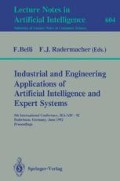Abstract
Problems of knowledge analysis for decision systems concerning diagnostic classification of mechanical objects are considered in this paper. Knowledge coming from experience is represented in a form of an information system and is analysed by means of the new approach based on the rough sets theory. The application of this approach enables reduction of superfluous data in the information system and generation of classification rules showing relationships between the description of objects and their assignment to classes of a technical state. The use of the rough sets approach is shown on a practical example concerning the evaluation of the technical state of rolling bearings. The bearings are in one of two technical states (good and bad) and are described by a set of symptoms which results from measurements of noise and vibration collected in an industrial environment.
Preview
Unable to display preview. Download preview PDF.
References
Y. Birger: Technical diagnostics. Nauka, Moscow (1978) (in Russian).
Cz. Cempel: Limit value in the practice of machine vibration diagnostics. Mechanical System and Signal Processing, 5 no. 6, 483–493 (1990).
Cz. Cempel: In Plant Determination Symptom Limit Value for Vibration Condition Monitoring. Proc. of Conf. on Technical Diagnostics, Prague, p 79–82 (1989).
J.Fibak, Z.Pawlak, K.Slowiński and R.Slowiński: Rough sets based decision algorithm for treatment of duodenal ulcer by HSV. Bull. PAS, Biological Series 34 (10–12), 227–246 (1986).
H. Finley: Principles of optimum maintance. Course materials. The Howard Finley Corporation (1988).
G.Gruszecki, R.Slowiński and J.Stefanowski: RoughDAS-Rough Sets Based Data Analysis Software — User manual, APRO S.A., Warszawa (1990).
A.Kelly and M.J.Harris: Management of industrial maintance. Newness-Butterworths, London (1978).
E.Krusińska, R.Slowiński and J.Stefanowski: Rough stes theory versus discriminant analysis. Applied Stochastic Models and Data Analysis 8 (2) (1992) (to appear).
Mitchell J.S.: An Introduction to Machinery Analysis and Monitoring, PannWell Books Company, Tulusa, Oklahoma (1981).
A.Mrozek: Rough sets and dependency analysis among attributes in computer implementation of expert inference models. International Journal of Man-Machine Studies 30, 457–473 (1989).
R.Nowicki, R.Slowinski, J.Stefanowski: Rough sets analysis of diagnostic capacity of vibroacoustic symptoms. Computers and Mathematics with Applications (1992) (to appear).
R.Nowicki, R.Słowiński and J.Stefanowski: Evaluation of Diagnostic Symptoms by Means of The Rough Sets Theory, Computers in Industry (1992) (to appear).
Z.Pawlak: Rough Sets. International Journal of Information and Computer Sciences 11 (5), 341–356 (1982).
Z.Pawlak: Rough classification. International Journal of Man-Machine Studies 20, 469–483 (1984).
Z.Pawlak: Rough sets. Some aspects of reasoning about knowledge, Kluwer Academic Publishers, Dordrecht (1991).
Z.Pawlak, K.Słowiński and R.Słowiński: Rough classification of patients after highly selective vagotomy for duodenal ulcer. International Journal of Man-Machine Studies, 24, 413–433 (1986).
R.Słowiński and J.Stefanowski: Rough classification in incomplete information systems. Mathematical and Computing Modelling, 12 (10–11), 1347–1357 (1989).
J.Stefanowski, Classification support based on the rough sets theory, Proc. of the IIASA Workshop on the User-Oriented Methodology and Techniques of Decision Analysis and Support, Serock, September 1991 (to appear).
Author information
Authors and Affiliations
Editor information
Rights and permissions
Copyright information
© 1992 Springer-Verlag Berlin Heidelberg
About this paper
Cite this paper
Stefanowski, J., Słowiński, R., Nowicki, R. (1992). The rough sets approach to knowledge analysis for classification support in technical diagnostics of mechanical objects. In: Belli, F., Radermacher, F.J. (eds) Industrial and Engineering Applications of Artificial Intelligence and Expert Systems. IEA/AIE 1992. Lecture Notes in Computer Science, vol 604. Springer, Berlin, Heidelberg. https://doi.org/10.1007/BFb0025009
Download citation
DOI: https://doi.org/10.1007/BFb0025009
Published:
Publisher Name: Springer, Berlin, Heidelberg
Print ISBN: 978-3-540-55601-5
Online ISBN: 978-3-540-47251-3
eBook Packages: Springer Book Archive

